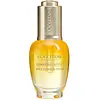What's inside
What's inside
 Key Ingredients
Key Ingredients

 Benefits
Benefits

 Concerns
Concerns

 Ingredients Side-by-side
Ingredients Side-by-side

Caprylic/Capric Triglyceride
MaskingCoco-Caprylate/Caprate
EmollientHelianthus Annuus Seed Oil
EmollientOlea Europaea Fruit Oil
MaskingPolyglyceryl-2 Isostearate/Dimer Dilinoleate Copolymer
EmollientOlax Dissitiflora Root Oil
TonicCanola Oil
EmollientVitis Vinifera Seed Oil
EmollientOenothera Biennis Oil
EmollientGlyceryl Caprylate
EmollientPersea Gratissima Oil
Skin ConditioningTocopherol
AntioxidantDaucus Carota Sativa Seed Oil
EmollientHydrolyzed Carrot Extract
Skin ConditioningVegetable Oil
Skin ConditioningTocopheryl Acetate
AntioxidantBeta-Carotene
Skin ConditioningFoeniculum Vulgare Oil
EmollientMelaleuca Alternifolia Leaf Oil
AntioxidantMentha Piperita Oil
MaskingCaprylic/Capric Triglyceride, Coco-Caprylate/Caprate, Helianthus Annuus Seed Oil, Olea Europaea Fruit Oil, Polyglyceryl-2 Isostearate/Dimer Dilinoleate Copolymer, Olax Dissitiflora Root Oil, Canola Oil, Vitis Vinifera Seed Oil, Oenothera Biennis Oil, Glyceryl Caprylate, Persea Gratissima Oil, Tocopherol, Daucus Carota Sativa Seed Oil, Hydrolyzed Carrot Extract, Vegetable Oil, Tocopheryl Acetate, Beta-Carotene, Foeniculum Vulgare Oil, Melaleuca Alternifolia Leaf Oil, Mentha Piperita Oil
Caprylic/Capric Triglyceride
MaskingHelianthus Annuus Seed Oil
EmollientOctyldodecanol
EmollientCoco-Caprylate/Caprate
EmollientSqualane
EmollientBorago Officinalis Seed Oil
EmollientHelichrysum Italicum Extract
AntiseborrhoeicHelichrysum Italicum Flower Oil
MaskingPrunus Armeniaca Kernel Oil
MaskingOenothera Biennis Oil
EmollientRosa Moschata Seed Oil
EmollientMyrtus Communis Oil
MaskingHippophae Rhamnoides Oil
EmollientCamelina Sativa Seed Oil
Skin ConditioningPelargonium Graveolens Oil
MaskingCitrus Aurantium Dulcis Oil
MaskingEchium Plantagineum Seed Oil
Skin ConditioningTocopherol
AntioxidantParfum
MaskingLimonene
PerfumingLinalool
PerfumingGeraniol
PerfumingCitronellol
PerfumingCitral
PerfumingCaprylic/Capric Triglyceride, Helianthus Annuus Seed Oil, Octyldodecanol, Coco-Caprylate/Caprate, Squalane, Borago Officinalis Seed Oil, Helichrysum Italicum Extract, Helichrysum Italicum Flower Oil, Prunus Armeniaca Kernel Oil, Oenothera Biennis Oil, Rosa Moschata Seed Oil, Myrtus Communis Oil, Hippophae Rhamnoides Oil, Camelina Sativa Seed Oil, Pelargonium Graveolens Oil, Citrus Aurantium Dulcis Oil, Echium Plantagineum Seed Oil, Tocopherol, Parfum, Limonene, Linalool, Geraniol, Citronellol, Citral
 Reviews
Reviews

Ingredients Explained
These ingredients are found in both products.
Ingredients higher up in an ingredient list are typically present in a larger amount.
This ingredient is an emollient, solvent, and texture enhancer. It is considered a skin-softener by helping the skin prevent moisture loss.
It helps thicken a product's formula and makes it easier to spread by dissolving clumping compounds.
Caprylic Triglyceride is made by combining glycerin with coconut oil, forming a clear liquid.
While there is an assumption Caprylic Triglyceride can clog pores due to it being derived from coconut oil, there is no research supporting this.
Learn more about Caprylic/Capric TriglycerideCoco-Caprylate/Caprate is created from fatty coconut alcohol, caprylic acid, and capric acid.
It is a lightweight emollient. Emollients create a thin barrier on the skin to trap moisture in. This helps keep your skin hydrated and soft.
Once applied, Coco-Caprylate/Caprate is absorbed quickly and leaves a silky feel.
Coco-Caprylate/Caprate may not be fungal acne safe.
Learn more about Coco-Caprylate/CaprateHelianthus Annuus Seed Oil is the oil derived from the seeds of a Sunflower. Sunflower seed oil is non-fragrant. It is an emollient, meaning it helps to soften the skin.
Sunflower seed oil contains many fatty acids. The fatty acids found in sunflower seeds include (from highest amount to least): linoleic acid, myristic acid, palmitic acid, stearic acid, arachidic acid, oleic acid, and linolenic acid.
These fatty acids help the skin create ceramides. Ceramides play a role in repairing the skin barrier.
Helianthus Annuus Seed Oil helps moisturize the skin. This in turn helps the skin look more rejuvenated and smoother.
Sunflowers are rich in vitamin E.
Historians believe Indigenous cultures of North America domesticated sunflowers before corn. Thus they relied on sunflower oil for a variety of uses. One such use is moisturizing skin and hair.
Sunflower seed oil may not be fungal acne safe. We recommend speaking with a professional if you have any concerns.
Learn more about Helianthus Annuus Seed OilOenothera Biennis Oil is the fixed oil derived from the seeds of the Evening Primrose.
Evening primrose oil is rich in fatty acids. These fatty acids include linoleic (60-85%), oleic (5-12%), palmitic (4-10%), and stearic (2-4%).
The fatty acid composition makes it a great ingredient for soothing and moisturizing skin. However, it may not be Malassezia folliculitis, or fungal acne safe.
Further research is needed on the role of evening primrose in treating eczema.
Evening primrose is native to North America.
Learn more about Oenothera Biennis OilTocopherol (also known as Vitamin E) is a common antioxidant used to help protect the skin from free-radicals and strengthen the skin barrier. It's also fat soluble - this means our skin is great at absorbing it.
Vitamin E also helps keep your natural skin lipids healthy. Your lipid skin barrier naturally consists of lipids, ceramides, and fatty acids. Vitamin E offers extra protection for your skin’s lipid barrier, keeping your skin healthy and nourished.
Another benefit is a bit of UV protection. Vitamin E helps reduce the damage caused by UVB rays. (It should not replace your sunscreen). Combining it with Vitamin C can decrease sunburned cells and hyperpigmentation after UV exposure.
You might have noticed Vitamin E + C often paired together. This is because it is great at stabilizing Vitamin C. Using the two together helps increase the effectiveness of both ingredients.
There are often claims that Vitamin E can reduce/prevent scarring, but these claims haven't been confirmed by scientific research.
Learn more about Tocopherol